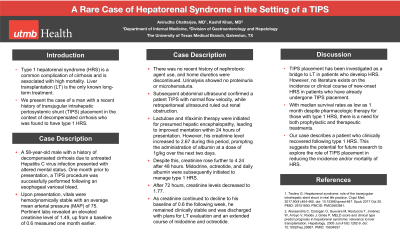Sunday Poster Session
Category: Liver
P1410 - A Rare Case of Hepatorenal Syndrome in the Setting of a TIPS
Sunday, October 27, 2024
3:30 PM - 7:00 PM ET
Location: Exhibit Hall E

Has Audio

Anirudha Chatterjee, MD
University of Texas Medical Branch
Galveston, TX
Presenting Author(s)
Anirudha Chatterjee, MD, Kashif Khan, MD
University of Texas Medical Branch, Galveston, TX
Introduction: Type 1 hepatorenal syndrome (HRS) is a common complication of cirrhosis and is associated with high mortality. Liver transplantation (LT) is the only known long-term treatment. We present the case of a man with a recent history of transjugular intrahepatic portosystemic shunt (TIPS) placement in the context of decompensated cirrhosis who was found to have type 1 HRS.
Case Description/Methods: A 58-year-old male with a history of decompensated cirrhosis due to untreated Hepatitis C virus infection presented with altered mental status. One month prior to presentation, a TIPS procedure was successfully performed following an esophageal variceal bleed. Upon presentation, vitals were hemodynamically stable with an average mean arterial pressure (MAP) of 75. Pertinent labs revealed an elevated creatinine level of 1.49, up from a baseline of 0.6 measured one month earlier. There was no recent history of nephrotoxic agent use, and home diuretics were discontinued. Urinalysis showed no proteinuria or microhematuria. Subsequent abdominal ultrasound confirmed a patent TIPS with normal flow velocity, while retroperitoneal ultrasound ruled out renal obstruction. Lactulose and rifaximin therapy were initiated for presumed hepatic encephalopathy, leading to improved mentation within 24 hours of presentation. However, his creatinine level increased to 2.67 during this period, prompting the administration of albumin at a dose of 1g/kg over the next two days. Despite this, creatinine rose further to 4.24 after 48 hours. Midodrine, octreotide, and daily albumin were subsequently initiated to manage type 1 HRS. After 72 hours, creatinine levels decreased to 1.77. As creatinine continued to decline to his baseline of 0.6 the following week, he remained clinically stable and was discharged with plans for LT evaluation and an extended course of midodrine and octreotide.
Discussion: TIPS placement has been investigated as a bridge to LT in patients who develop HRS. However, no literature exists on the incidence or clinical course of new-onset HRS in patients who have already undergone TIPS placement. With median survival rates as low as 1 month despite pharmacologic therapy for those with type 1 HRS, there is a need for both prophylactic and therapeutic treatments. Our case describes a patient who clinically recovered following type 1 HRS. This suggests the potential for future research to explore the role of TIPS placement in reducing the incidence and/or mortality of HRS.
Disclosures:
Anirudha Chatterjee, MD, Kashif Khan, MD. P1410 - A Rare Case of Hepatorenal Syndrome in the Setting of a TIPS, ACG 2024 Annual Scientific Meeting Abstracts. Philadelphia, PA: American College of Gastroenterology.
University of Texas Medical Branch, Galveston, TX
Introduction: Type 1 hepatorenal syndrome (HRS) is a common complication of cirrhosis and is associated with high mortality. Liver transplantation (LT) is the only known long-term treatment. We present the case of a man with a recent history of transjugular intrahepatic portosystemic shunt (TIPS) placement in the context of decompensated cirrhosis who was found to have type 1 HRS.
Case Description/Methods: A 58-year-old male with a history of decompensated cirrhosis due to untreated Hepatitis C virus infection presented with altered mental status. One month prior to presentation, a TIPS procedure was successfully performed following an esophageal variceal bleed. Upon presentation, vitals were hemodynamically stable with an average mean arterial pressure (MAP) of 75. Pertinent labs revealed an elevated creatinine level of 1.49, up from a baseline of 0.6 measured one month earlier. There was no recent history of nephrotoxic agent use, and home diuretics were discontinued. Urinalysis showed no proteinuria or microhematuria. Subsequent abdominal ultrasound confirmed a patent TIPS with normal flow velocity, while retroperitoneal ultrasound ruled out renal obstruction. Lactulose and rifaximin therapy were initiated for presumed hepatic encephalopathy, leading to improved mentation within 24 hours of presentation. However, his creatinine level increased to 2.67 during this period, prompting the administration of albumin at a dose of 1g/kg over the next two days. Despite this, creatinine rose further to 4.24 after 48 hours. Midodrine, octreotide, and daily albumin were subsequently initiated to manage type 1 HRS. After 72 hours, creatinine levels decreased to 1.77. As creatinine continued to decline to his baseline of 0.6 the following week, he remained clinically stable and was discharged with plans for LT evaluation and an extended course of midodrine and octreotide.
Discussion: TIPS placement has been investigated as a bridge to LT in patients who develop HRS. However, no literature exists on the incidence or clinical course of new-onset HRS in patients who have already undergone TIPS placement. With median survival rates as low as 1 month despite pharmacologic therapy for those with type 1 HRS, there is a need for both prophylactic and therapeutic treatments. Our case describes a patient who clinically recovered following type 1 HRS. This suggests the potential for future research to explore the role of TIPS placement in reducing the incidence and/or mortality of HRS.
Disclosures:
Anirudha Chatterjee indicated no relevant financial relationships.
Kashif Khan indicated no relevant financial relationships.
Anirudha Chatterjee, MD, Kashif Khan, MD. P1410 - A Rare Case of Hepatorenal Syndrome in the Setting of a TIPS, ACG 2024 Annual Scientific Meeting Abstracts. Philadelphia, PA: American College of Gastroenterology.
